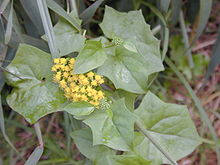- Delairea
-
Delairea 
Scientific classification Kingdom: Plantae (unranked): Angiosperms (unranked): Eudicots (unranked): Asterids Order: Asterales Family: Asteraceae Tribe: Senecioneae Genus: Delairea
Lem.[2]Species: D. odorata Binomial name Delairea odorata[1]
Lem.Delairea is a plant genus within the family Asteraceae. It is classified within tribe Senecioneae. It contains only one species, Delairea odorata, which was previously included in the genus Senecio as Senecio mikanioides,[3] and is known as cape ivy in some parts of the world and German ivy in others,
Delairea odorata is native to South Africa. The name cape ivy is also used ambiguously for Senecio angulatus, a different creeper.
Contents
Appearance and uses
Delairea odorata has 2 to 4 -inch multi-lobed leaves that somewhat resemble those of the unrelated English ivy. Its flowers are yellow. A feature that distinguishes it from Senecio angulatus are the small appendages at the base of the stalks of the leaves that are shaped like an ear.
This plant is grown as an ornamental houseplant for its foliage.
Growth
Delairea odorata is a vine that climbs up trees and will reach heights of five metres in suitable climates. Given time it will smother trees.
Ecological impact and control methods
Delairea odorata has become an invasive species in California, Hawaii, Oregon, New Zealand and Australia. The plant will cover shrubs and trees, inhibiting growth and will also cover ground intensively over a wide area, thereby preventing seeds from germinating or growing.
The creeper can be controlled or eliminated by a combination of physical and chemical methods. Unless the root system is removed or poisoned the plant will regrow. Young plants can be pulled out with their roots but older plants will break off leaving the roots in place.
References
- ^ Integrated Taxonomic Information System Organization (ITIS) (1999). "Delairea Lem" (HTML). Integrated Taxonomic Information System on-line database. http://www.itis.gov/servlet/SingleRpt/SingleRpt?search_topic=TSN&search_value=564844. Retrieved 2008-03-31.
- ^ Natural Resources Conservation Service (NRCS). "PLANTS Profile, Delairea Lem" (HTML). The PLANTS Database. United States Department of Agriculture,. http://plants.usda.gov/index.html. Retrieved 2008-03-31.
- ^ Eda, Sayaka (1999). "The Biogeography of Cape Ivy (Delairea odorata)". http://bss.sfsu.edu/holzman/courses/Fall99Projects/capeivy.htm. Retrieved 2007-05-20
- Crockett, James (1972). Foliage House Plants. New York, NY: Time-Life Books. pp. 142–143.
- Nelson, Dave (1999). "Invasive Exotic Cape Ivy". http://www.ventanawild.org/news/se99/capeivy.html. Retrieved 2007-05-07.
- Greater Wellington Regional Council, New Zealand. "Greater Wellington - German ivy (Senecio mikanioides)". http://www.gw.govt.nz/story10945.cfm?. Retrieved 2008-01-16.[dead link]
- Greater Wellington Regional Council, New Zealand. "Greater Wellington - Cape ivy (Senecio angulatus)". http://www.gw.govt.nz/story10951.cfm?. Retrieved 2008-01-16.[dead link]
External links
 Data related to Delairea at Wikispecies
Data related to Delairea at Wikispecies  Media related to Delairea at Wikimedia Commons
Media related to Delairea at Wikimedia Commons
This Senecioneae-related article is a stub. You can help Wikipedia by expanding it.

